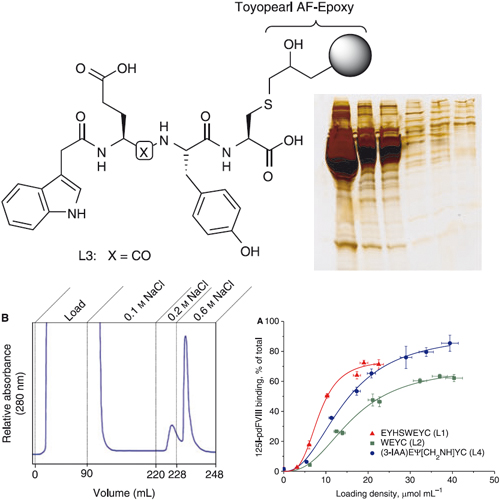Efficient factor VIII affinity purification using a small synthetic ligand
09-Jan-2008
Journal of Thrombosis and Haemostasis, 2008, Vol. 6, 470-7 published on 09.01.2008
Journal of Thrombosis and Haemostasis, online article
Journal of Thrombosis and Haemostasis, online article
BACKGROUND: Hemophilia A is currently treated by infusions of the coagulation factor (F) VIII, of which production and purification remain a challenging task. Current purification procedures using immunoaffinity chromatography are cumbersome, expensive, and suffer from the instability of the applied antibody ligands, which elute along with the product and contaminate it. Recently, FVIII was purified using octapeptide ligands, but their use is limited due to the low resistance to proteases. OBJECTIVE: Our goal was to develop and evaluate a novel ligand for FVIII purification, overcoming the drawbacks of current procedures. METHODS: Peptide ligands were screened for binding of (125)I-plasma-derived-FVIII (pdFVIII) in a microbead assay. A selected ligand-coated Toyopearl resin was then used for pdFVIII purification from cell-conditioned Delbucco's modified Eagle's medium (DMEM) containing fetal bovine serum. The proteolytic stability of ligand was measured by incubating with human serum and proteinase K, and its cytotoxicity towards human OV-MZ-6 cells was assayed. RESULTS: A high-affinity octapeptidic FVIII ligand was modified into the small, highly stable and non-toxic peptidomimetic ligand L4 by rational and combinatorial design without affecting its affinity for FVIII. Using ligand L4-coated Toyopearl resin, pdFVIII was isolated from cell-conditioned medium with high purity and 89% column retention after elution with a mild buffer containing 0.6 m NaCl at pH 6.8. CONCLUSIONS: Ligand L4 offers a valuable alternative to antibody-based procedures for laboratory and industrial production. Its synthesis by established solid-phase procedures is straightforward and considerably cheaper than the biotechnological production of antibodies, and safety concerns associated with the use of biological material are overcome.











